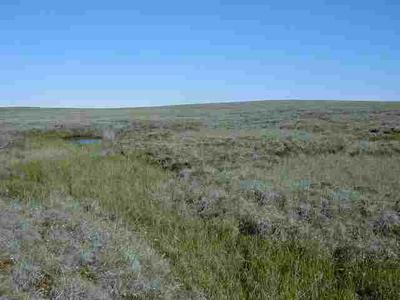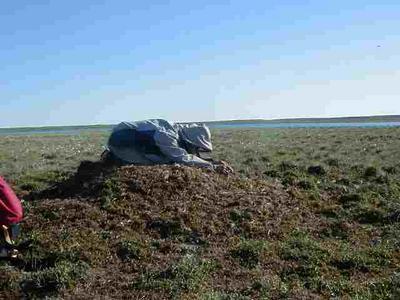
|
|
19 July, 2002
July 19, 2002
No sound or sight of a helicopter, yet - looks like I'll get another
night of enjoyment in my little yellow NorthFace VE-25 tent! Last
night was great - as long as sleep isn't the priority - as I laid
awake deep into the early morning hours due to the noisy swans in our
nearby lakes! Today was a beautiful weather day (which means no bug
plague!). As I am trying to prepare for the end, I want to make sure
and tell you everything, but am afraid I'll never clearly explain
all. I did mention a couple days ago that I've learned a lot from the
tundra. The learning goes beyond just naming birds. I've learned much
about field research, bird biology and some about teaching, as well.
First, as a science teacher, I feel it is important to encourage
students to make good, detailed observations of things we are
studying. I also hope to motivate them to ask interesting,
thoughtful, science questions. As I've been out here learning myself,
I realize that just telling somebody to make accurate observations or
encouraging them to ask questions isn't enough. As the summer has
progressed, I've realized that my observations are becoming much more
accurate and detailed. Although I've always wanted to make the best
observations, it was not until I've made many that my observations
could be accurate. By seeing many different birds a number of times,
I began to see the detail. At first, they were just birds. Then, some
had a long beak or some had a short beak. Some were brown with white
bellies, some were white with black bellies. As I continued looking,
I started seeing that some of the short-billed, brown with white
bellied birds had some differences. One I noticed had a white eye
patch. Another I noticed had orange legs. That is when I really began
to identify birds. They weren't just sandpipers, they were
semipalmated sandpipers, pectoral sandpipers, stilt sandpipers! Just
the desire to make good observations isn't enough. It takes practice
and it takes experience. It takes a certain body of knowledge or
previous observations to know what it is you should look at to
compare and contrast. As a teacher, I realize that I must provide
similar opportunities to students if I really want them to become
better observers!
The same is true of questions. At first, my questions were basic -
how many eggs does that bird lay? How does a hen incubate the eggs?
What is a brood? Why do they molt? As the summer has progressed, I
became more interested in the subtleties of the birds. That is when
my own questioning changed to ones of a higher level. What would
happen if the eggs were incubated at a higher temperature or lower
temperature? What physiological changes occur to allow the hen to
develop a brood patch and become an effective incubator? Chickens lay
unfertilized eggs, would a bird in the wild ever lay eggs that were
also unfertilized? Again, before I could get to a point to ask these
questions, learning had to take place first. I needed the basics of
ornithology. I needed the vocabulary to communicate with the rest of
the group. Most of all, though, I needed to become interested in the
subject. Once I was hooked (began to enjoy watching the birds and
wondering if they would have a successful summer), then the questions
became more clear. I 'wanted' to learn more. Even more exciting, at
that point, I was motivated to try to read more and find the answers
myself. As a teacher, that will be my goal. Hook the students - get
them excited about the subject matter, get them involved in the
subject, expose them to things they don't know - then, maybe, I can
really get them to learn!
The science learned is also exciting! As a re-cap of the summer
research, we collected data on # and size of eggs, location of nests,
success of nests, estimations of hatching dates, habitat descriptions
and incubation temperatures of the nests. We collected down from the
nests and we attempted to track the hens with her young to collect
data on direction and rate of movement. Why did we want this
information? (Hopefully YOU asked that question)
Over the next couple days, I hope to explain to you why we wanted the
data and provide you with some of our preliminary results. I believe
in a journal entry about a month ago, I provided the data on average
# eggs/nest, as well as the average length, width and mass of the
eggs. There is a basic reason that data is valuable - science wants
to know! Science is the search of answers to questions, and that is
just a basic question in regards to the breeding biology of birds.
The information could be useful if nests were compared between two
slightly different habitat areas or between two summers that differed
slightly in temperatures or precipitation. There are many different
ways to look at how/why eggs have a parcticular size!
In the last couple of days, we've finished returning to nests to
determine which were successful vs. depredated. If a nest is found
with young, it is obviously successful. Also, if the nest is found
with egg shell fragments, and more importantly, egg membranes, the
nest would be considered successful. If the nest's lining is torn
apart, egg shells are found in just 2-3 pieces and/or there are no
membranes, it would be recorded as unsuccessful or depredated.
I took the time to count up all the nests we've monitored and tally
up our unofficial results. For the King Eiders, only 12/41 nests were
successful. With the Tundra Swans, 7/12 nests successfully hatched.
The White-Fronted Geese succeeded in 27/34 of the nests we've
re-checked. So, with a little quick math work, only about 23% of the
King Eiders studied were able to pass their genes on to live
ducklings; approximately 60% of the swan couples now have offspring
with their mix of genes; and almost 70% of the geese succeeded in
life's ultimate goal of getting their genes passed onto the next
generation.
Those numbers should get you asking questions! Why was the success
rate so low with the King Eiders? How will the population be affected
in the future? Are 'low' years typical at times Š. Is successful
hatching somewhat cyclical? How is nest success related to the number
of foxes or gulls or terns or bears in the area? Is there any
relationship between earlier spring warming and nesting success? And
even more questions when you start looking at the swans and geese.
Those are the ultimate questions! Some of the other data we collected
may help to provide insight into the 'why's', but that is the
exciting part of science. Answers only lead you to more questions!
Tomorrow, I'll explain a little about incubation temperatures,
habitat evaluations and radiotelemetry work (tracking) of birds.
Please join me with more questions! Or, better yet, email me your
questions! Or, even better yet, join us on July 22 and July 25 via
the website for a life web broadcast! The broadcast on the 22nd is
scheduled for 3:30 pm EST, and the 25th for 10:00 am MST. If you
join, you will be able to listen to conversations between me and a
group of other teachers and students. You will also be able to see
related pictures to the topics we discuss and email in questions that
I can answer immediately. Please join us!
Details of the Live WebBroadcasts:TEALive Broadcast - Connect with
TEAs in the Arctic!
Monday July 22 at 3:30 pm ET with Kim Hanisch
Kim's Expedition Description & Journal:
../tea_hanischfrontpage.html
The July 22 broadcast will also include a group of teachers from
Brooklyn College working at the American Museum of Natural History.
Thursday July 25 at 12:00 pm ET with with Kim Hanisch
Kim's Expedition Description & Journal:
../tea_hanischfrontpage.html
You can access the TEALive Real Audio sessions and software through:
http://www.wrps.org/tea/
To test your connection -- you can test your connection anytime by
clicking on the "Listen to a Previous Broadcast" link at
http://www.wrps.org/tea/ and selecting any of the broadcasts listed.
We invite you, your students, and colleagues to e-mail questions for
the live broadcast before and during the RealAudio session from the
e-mail link at ../tea_newsfrontpage.html (or email
directly to broadcast@tea.rice.edu). The questions will be provided
to the TEA in the field during the session by the broadcast host.

This is an example of part of a Low Centered Polygon that is now dry. The raised edges of the polygon are created by frost heaves (ice/water freezing and melting within the soil and vegetation). Between the two raised ridges of adjacent polygons is a 'trench' which is usually filled with water. On the other side of the raised area, is a low-lying meadow like area which used to be filled with a few inches of water. Finally, in the top part of the picture, you may see water standing in the 'trough' formed where 3 or more polygons and their trenches unite.

This is me relaxing in the same swan next. Definitely shows you how small Yumiko is compared to me! Actually though, the nest is as wide as I am tall!

This is Yumiko pretending she is a swan sitting in her nest. Definitely shows, though the size of the nests of these beautiful birds build!
Contact the TEA in the field at
.
If you cannot connect through your browser, copy the
TEA's e-mail address in the "To:" line of
your favorite e-mail package.
|
